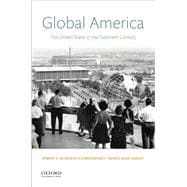Global America tells the story of how Americans were swept up in the swift-moving currents of twentieth-century world history. Drawing on the latest research on the history of the United States in the world, it demonstrates how global interactions and developments transformed both America and the world.
Global America weaves together topics such as social reform, the world wars, and the rise of conservatism in a way that helps readers gain a fresh understanding of America's place in the world. It pays particular attention to themes of race, class, and gender and how each has shaped--and been shaped by--U.S. engagement with the world. In connecting U.S. and world history, Global America argues that the more America sought to change the world, the more the world changed America.
Global America offers a synthesis accessible to undergraduates. The chapters are organized chronologically, beginning with the 1890s and ending in 2013. Starting with U.S. expansion in the late nineteenth century, the book situates American developments within the context of major political and economic events, explores key developments in culture and society, and ends with the rise and partial decline of American power in recent years.








